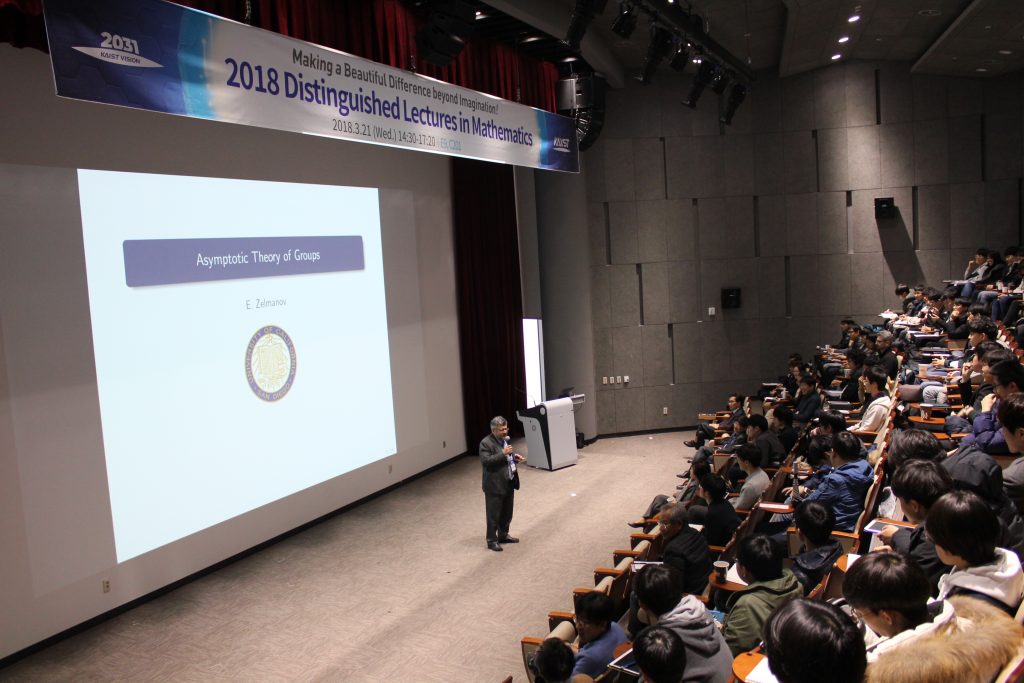KAIST invited two internationally renowned mathematicians, Efim Zelmanov and Gang Tian, during its vision week, an event held for the week of March 20-23, 2018 to announce “KAIST’s 2031 Vision.” Under the vision, KAIST will strive for a significant development to join the ranks of the world’s top ten universities by 2031, a year the school marks its 60th anniversary.
On March 21st, Zelmanov and Tian gave talks in turns to the general public at the newly open Academic Cultural Complex on campus.
In his special lecture entitled “Asymptotic Group Theory,” Zelmanov, who received the Fields Medal in 1994 for his work in group theory, shared some of his recent research outcomes. He discussed the limits of finite groups and their connections with other fields, such as theoretical computer science, number theory, algebraic topology, combinatorial and geometric group theory, etc.
An expert in abstract algebra, Zelmanov has studied algebraic structures known as “groups.” He has garnered a reputation for his work on combinatorial problems in non-associative algebra and group theory, including his contribution to solve the restricted Burnside problem. In 1989, he proved that the restricted Burnside problem always has a positive solution for higher prime powers, for which he received the Fields Medal.
A native of Russia, Zelmanov obtained his doctoral degree in mathematics from Novosibirsk State University in 1980 and a higher degree at Leningrad State University in 1985. From 1990 to 2001, he was a professor at the University of Wisconsin-Madison, University of Chicago, and Yale University. He has been working at the University of California, San Diego, since being appointed as the Rita L. Atkinson Chair in Mathematics in 2002. From 1996 to date, he has also been serving as a distinguished professor at the Korea Institute of Advanced Study in Korea.
In addition to the Fields Medal, his honors include a member of the American Academy of Arts and Sciences (1996) and the U.S. National Academy (2001); a foreign member of the Spanish Royal Academy of Sciences (1997) and the Korean Academy of Science and Technology (2008); and a fellow of the American Mathematical Society (2012).
Following Zelmanov’s talk, a prominent Chinese mathematician in geometry, Gang Tian, took the stage in front of over 150 audiences and introduced two famous open questions in topology, the Poincaré and geometrization conjectures—both conjectures were solved by a Russian mathematician Grigori Perelman in 2002-2003 though.
In his talk entitled “Poincaré Conjecture and Geometrization,” Tian explained about the Poincaré conjecture and a brief history of the mathematical community’s endeavors to pursue the problem. He also showed geometric ideas involved in solving the conjecture, the geometrization of 3-spaces, in particular. He concluded his lecture with some speculations on future developments in geometry.
The next day on March 22nd, Tian gave expert talks entitled “Geometrization and Curvature Flows, I & II” in two separate sessions to the students and faculty members of the Mathematical Sciences Department, touching on a variety of issues such as Ricci flow, analytic minimal model program, and birational classification of Kähler manifolds through geometric methods.
Currently serving as the vice president of Chinese Mathematical Society and Peking University, Gang has had an outstanding career in higher education, taking up professorships at Princeton University, the State University of New York in Stony Brook, New York University, the Massachusetts Institute of Technology (MIT), and Peking University, China.
Tian has made major contributions to the advancement of differential and symplectic geometry, geometric analysis, and differential equations. He received the Oswald Veblen Prize in 1996, a highly regarded award granted by the American Mathematical Society for notable research in geometry or topology, as well as Alfred P. Sloan Research Fellow (1991-1993), the 19th Alan Waterman Award (1994), Chinese Academy of Sciences Fellow (2001), and American Academy of Arts and Sciences Fellow (2004).
Graduated from Nanjing University, China, in 1982, he earned his master’s degree from Peking University in 1984 and a doctoral degree from Harvard University in 1988.



